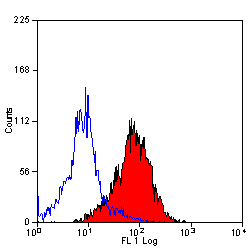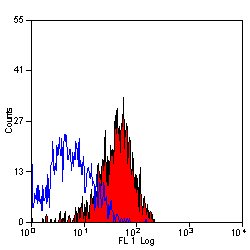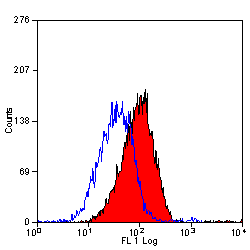CD49d antibody | PS/2




Rat anti Mouse CD49d:Alexa Fluor® 488
- Product Type
- Monoclonal Antibody
- Clone
- PS/2
- Isotype
- IgG2b
- Specificity
- CD49d
| Rat anti Mouse CD49d monoclonal antibody, clone PS/2 recognizes murine alpha 4 integrin (CD49d), a ~150 kDa single pass type I membrane glycoprotein that can associate with either beta 1 integrin (CD29) or beta 7 integrin to form heterodimers CD49d/CD29 (VLA-4) and alpha4/beta7 (LPAM-1) respectively (Holzmann et al. 1989). CD49d is expressed on most lymphocytes, granulocytes, monocytes and thymocytes. The primary ligands for CD49d are CD106 (VCAM-1), fibronectin and MAdCAM-1 (Sheppard et al. 1994). Clone PS/2 has also been reported to block the binding of CD49d to its ligands (Andrew et al. 1994). |
- Target Species
- Mouse
- Species Cross-Reactivity
-
Target Species Cross Reactivity Human - N.B. Antibody reactivity and working conditions may vary between species.
- Product Form
- Purified IgG conjugated to Alexa Fluor® 488 - liquid
- Preparation
- Purified IgG prepared by affinity chromatography on Protein G from tissue culture supernatant
- Buffer Solution
- Phosphate buffered saline
- Preservative Stabilisers
- 0.09% sodium azide (NaN3)
1% bovine serum albumin - Immunogen
- P815 DBA/2 murine mastocytoma cells.
- Approx. Protein Concentrations
- IgG concentration 0.05 mg/ml
- Fusion Partners
- Spleen cells from immunized Fisher rats were fused with SP2/0 mouse myeloma cells
- Max Ex/Em
-
Fluorophore Excitation Max (nm) Emission Max (nm) Alexa Fluor®488 495 519 - Regulatory
- For research purposes only
- Guarantee
- 12 months from date of despatch
- Acknowledgements
- The Alexa Fluor dye antibody conjugates in this product are sold under license from Molecular Probes, Inc. for research use only, except for use in combination with microarrays, and are covered by pending and issued patents.
Avoid repeated freezing and thawing as this may denature the antibody. Storage in frost-free freezers is not recommended. This product is photosensitive and should be protected from light.
| Application Name | Verified | Min Dilution | Max Dilution |
|---|---|---|---|
| Flow Cytometry | Neat |
| Description | Product Code | Applications | Pack Size | List Price | Your Price | Quantity | |
|---|---|---|---|---|---|---|---|
| Mouse Seroblock FcR | BUF041A | F | 0.1 mg |
|
Log in | ||
| List Price | Your Price | ||||||
|
|
Log in | ||||||
| Description | Mouse Seroblock FcR | ||||||
| Mouse Seroblock FcR | BUF041B | F | 0.5 mg |
|
Log in | ||
| List Price | Your Price | ||||||
|
|
Log in | ||||||
| Description | Mouse Seroblock FcR | ||||||
References for CD49d antibody
-
Miyake, K. et al. (1991) Evidence for a role of the integrin VLA-4 in lympho-hemopoiesis.
J Exp Med. 173 (3): 599-607. -
Miyake, K. et al. (1991) A VCAM-like adhesion molecule on murine bone marrow stromal cells mediates binding of lymphocyte precursors in culture.
J Cell Biol. 114 (3): 557-65. -
Andrew, D.P. et al. (1994) Distinct but overlapping epitopes are involved in alpha 4 beta 7-mediated adhesion to vascular cell adhesion molecule-1, mucosal addressin-1, fibronectin, and lymphocyte aggregation.
J Immunol. 153 (9): 3847-61. -
Tchilian, E.Z. et al. (1997) Anti-alpha 4 integrin antibody induces apoptosis in murine thymocytes and staphylococcal enterotoxin B-activated lymph node T cells.
Immunology. 92: 321-7. -
Enghofer, M. et al. (1998) Lymphocyte transfer in streptozotocin-induced diabetes: adhesion of donor cells to islet endothelium.
Am J Physiol. 274: E928-35. -
Liu, Z.J. et al. (1999) A novel role for H-Ras in the regulation of very late antigen-4 integrin and VCAM-1 via c-Myc-dependent and -independent mechanisms.
J Immunol. 163: 4901-8. -
Tanneau, G.M. et al. (1999) Differential recruitment of T- and IgA B-lymphocytes in the developing mammary gland in relation to homing receptors and vascular addressins.
J Histochem Cytochem. 47: 1581-92. -
Fukuoka, M. et al. (2000) Antiadhesive function of 130-kd glycoform of CD43 expressed in CD4 T-lymphocyte clones and transfectant cell lines.
Blood. 96: 4267-75.
View The Latest Product References
-
Hokibara, S. et al. (2000) Effects of monoclonal antibodies to adhesion molecules on eosinophilic myocarditis in Toxocara canis-infected CBA/J mice.
Clin Exp Immunol. 114: 236-44. -
Bowden, R.A. et al. (2002) Role of alpha4 integrin and VCAM-1 in CD18-independent neutrophil migration across mouse cardiac endothelium.
Circ Res. 90: 562-9. -
Hirata, T. et al. (2002) P-, E-, and L-selectin mediate migration of activated CD8+ T lymphocytes into inflamed skin.
J Immunol. 169: 4307-13. -
Maus, U.A. et al. (2004) Pneumolysin-induced lung injury is independent of leukocyte trafficking into the alveolar space.
J Immunol. 173: 1307-12. -
Ferrer, P. et al. (2005) Association between pterostilbene and quercetin inhibits metastatic activity of B16 melanoma.
Neoplasia. 7: 37-47. -
Eshghi, S. et al. (2007) Alpha4beta1 integrin and erythropoietin mediate temporally distinct steps in erythropoiesis: integrins in red cell development.
J Cell Biol. 177: 871-80. -
Vaz, R. et al. (2012) Fibronectin promotes migration, alignment and fusion in an in vitro myoblast cell model.
Cell Tissue Res. 348: 569-78. -
Zhang, Y. et al. (2012) Autotaxin through lysophosphatidic acid stimulates polarization, motility, and transendothelial migration of naive T cells.
J Immunol. 189: 3914-24. -
Gillberg, L. et al. (2013) Effective treatment of mouse experimental colitis by alpha 2 integrin antibody: comparison with alpha 4 antibody and conventional therapy.
Acta Physiol (Oxf). 207: 326-36. -
Omenetti, S. et al. (2015) Dysregulated intrahepatic CD4+ T-cell activation drives liver inflammation in ileitis-prone SAMP1/YitFc mice.
Cell Mol Gastroenterol Hepatol. 1 (4): 406-19. -
Chung, K.J. et al. (2017) A self-sustained loop of inflammation-driven inhibition of beige adipogenesis in obesity.
Nat Immunol. 18 (6): 654-64. -
Andrews, S.L. et al. (2023) SVEP1 influences monocyte to macrophage differentiation via integrin α4β1/α9β1 and Rho/Rac signalling.
Biochim Biophys Acta Mol Cell Res. 1870 (6): 119479.
- Synonyms
- Integrin Alpha 4 Chain
- VLA-4
- RRID
- AB_566805
- UniProt
- Q00651
- Entrez Gene
- Itga4
- GO Terms
- GO:0007157 heterophilic cell-cell adhesion
- GO:0001968 fibronectin binding
- GO:0001974 blood vessel remodeling
- GO:0004872 receptor activity
- GO:0008305 integrin complex
- GO:0007159 leukocyte cell-cell adhesion
- GO:0007229 integrin-mediated signaling pathway
- GO:0007507 heart development
- GO:0009897 external side of plasma membrane
- View More GO Terms
- GO:0016477 cell migration
- GO:0060324 face development
- GO:0060710 chorio-allantoic fusion
MCA1230A488
If you cannot find the batch/lot you are looking for please contact our technical support team for assistance.
Please Note: All Products are "FOR RESEARCH PURPOSES ONLY"
View all Anti-Mouse ProductsAlways be the first to know.
When we launch new products and resources to help you achieve more in the lab.
Yes, sign me up


